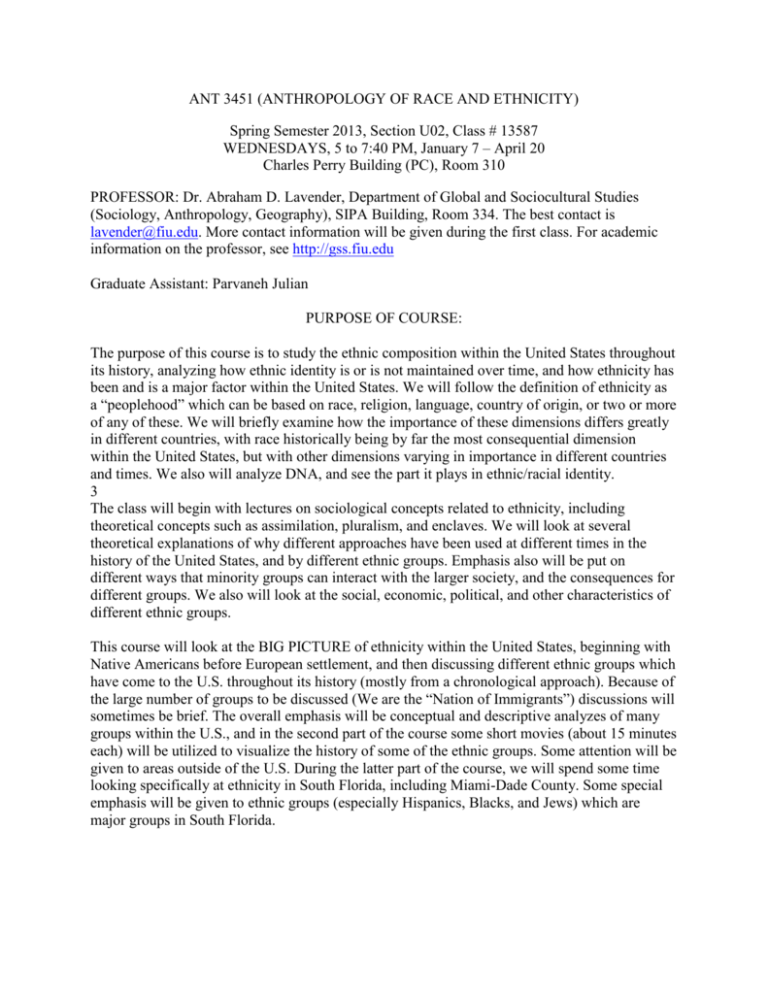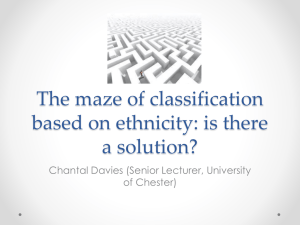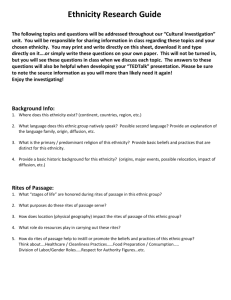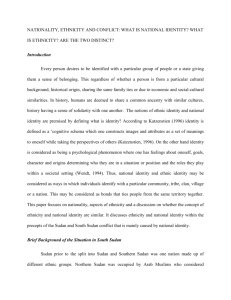Syllabus - Department of Global & Sociocultural Studies
advertisement

ANT 3451 (ANTHROPOLOGY OF RACE AND ETHNICITY) Spring Semester 2013, Section U02, Class # 13587 WEDNESDAYS, 5 to 7:40 PM, January 7 – April 20 Charles Perry Building (PC), Room 310 PROFESSOR: Dr. Abraham D. Lavender, Department of Global and Sociocultural Studies (Sociology, Anthropology, Geography), SIPA Building, Room 334. The best contact is lavender@fiu.edu. More contact information will be given during the first class. For academic information on the professor, see http://gss.fiu.edu Graduate Assistant: Parvaneh Julian PURPOSE OF COURSE: The purpose of this course is to study the ethnic composition within the United States throughout its history, analyzing how ethnic identity is or is not maintained over time, and how ethnicity has been and is a major factor within the United States. We will follow the definition of ethnicity as a “peoplehood” which can be based on race, religion, language, country of origin, or two or more of any of these. We will briefly examine how the importance of these dimensions differs greatly in different countries, with race historically being by far the most consequential dimension within the United States, but with other dimensions varying in importance in different countries and times. We also will analyze DNA, and see the part it plays in ethnic/racial identity. 3 The class will begin with lectures on sociological concepts related to ethnicity, including theoretical concepts such as assimilation, pluralism, and enclaves. We will look at several theoretical explanations of why different approaches have been used at different times in the history of the United States, and by different ethnic groups. Emphasis also will be put on different ways that minority groups can interact with the larger society, and the consequences for different groups. We also will look at the social, economic, political, and other characteristics of different ethnic groups. This course will look at the BIG PICTURE of ethnicity within the United States, beginning with Native Americans before European settlement, and then discussing different ethnic groups which have come to the U.S. throughout its history (mostly from a chronological approach). Because of the large number of groups to be discussed (We are the “Nation of Immigrants”) discussions will sometimes be brief. The overall emphasis will be conceptual and descriptive analyzes of many groups within the U.S., and in the second part of the course some short movies (about 15 minutes each) will be utilized to visualize the history of some of the ethnic groups. Some attention will be given to areas outside of the U.S. During the latter part of the course, we will spend some time looking specifically at ethnicity in South Florida, including Miami-Dade County. Some special emphasis will be given to ethnic groups (especially Hispanics, Blacks, and Jews) which are major groups in South Florida. READINGS: (1) NATIVE ROOTS: HOW THE INDIANS ENRICHED AMERICA, by Jack Weatherford. The title is descriptive; this book discusses Native American (Indian) contributions to the U.S. culture. While the professor lectures on concepts, definitions, theories, etc., in the first half of the course, read assigned chapter of this book. The first test will include questions from this book. (2) JOURNAL OF SPANISH, PORTUGUESE, AND ITALIAN CRYPO JEWS, VOLUME 4, SPRING 2012, edited by Abraham D. Lavender and Dolores Sloan. This book, comprised of nine articles, describes the meaning of ethnic and religious identity for one of the “classic” historical ethnic groups, and illustrates how changes can occur in ethnic identity. Assignments will be made to read during the first half of the semester, for the first test. (3) HAVING OUR SAY: THE DELANY SISTERS’ FIRST 100 YEARS, by Sarah L. Delany and A. Elizabeth Delany, with Amy Hill Hearth. This book, published in 1993, tells the story of two sisters who were born in 1889 (“Sadie”) and 1891 (“Bessie”), and who lived to ages 101 and 103. It is an easy-reading book which shows the life of African-Americans in this time period. Read this book in its entirety during the second part of the course. (4) THE NEW AMERICANS: HOW THE MELTING POT CAN WORK AGAIN, by Michael Barone. This book discusses six ethnic groups in the United States: Latinos, Blacks, Irish, Jews, Italians, and Asians. Each section, with about 40 pages, will be assigned during the semester, some for the first test and some for the second test. For the first test, read the chapters on Latinos and Blacks. The remainder of this book will be read in the second half of the class. (5) IN ADDITION, so that you can become aware of constantly changing current events relating to ethnicity, numerous articles/etc. on contemporary events and issues relating to ethnicity will be assigned during the semester, and you are responsible for the material on these readings. GRADING: There will be two tests. Test 1 will be about a week before the middle of the semester and Test 2 will be about one to two weeks before the end of the course (the exact date for each will be announced soon). Each test will have 33 questions. Because of the size of the class, the answers will be multiple-choice. Each test will be about half from class material and about half from assigned readings. The final grade (except for attendance) will be a combination of the tests, with the highest grade, whichever it is, counting 2/3s, and the lowest counting 1/3. ATTENDANCE: This is not a correspondence course or an online course, and attendance will be taken frequently. The professor reserves the right to adjust a grade downwards for any student who misses more than one-third of the classes when attendance is taken. On campus education also consists of the class atmosphere, hearing other student comments, observing class interactions, etc. There will be frequent class discussions, and students are encouraged to participate. Absences near the end of the semester, after Test 2, will count double.









